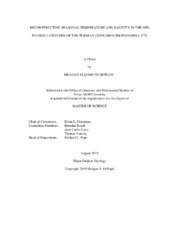| dc.description.abstract | We used oxygen and carbon isotopic compositions of Permian-aged brachiopods from Argentina, Western Australia, Arctic Canada, and West Spitsbergen to create high-resolution snapshots of the seasonal temperature and salinity patterns experienced by these mid- to high-latitudes and provide an in-depth peek at climates past. Brachiopods were examined in thin section and under cathodoluminescence to evaluate preservation and were milled along visible growth-associated banding to produce isotopic records that correspond with annual growth cycles of the specimens. The resulting δ^18O records generally exhibited systematic, cyclic variation across the specimen that are interpreted as seasonal changes in environmental conditions over the lifetime of the specimen. The isotopic records of the brachiopod shells vary with age and location. The Asselian-aged Argentinian brachiopod has consistently low δ^18O and δ^13C values. The seasonal variability in δ^18O was -4.6‰ to -5.4‰, which corresponds to a 4⁰C range in annual temperature (assuming no seasonal variation in seawater ^18O and thus salinity). Western Australian brachiopods, which are Sakmarian to Artinskian in age, yield the highest δ^18O values of the study, equivalent to a comparable annual temperature range of 5⁰C, but with substantially higher δ ^18O values (0.2‰ to -1.0‰). Arctic Canada brachiopods yield the smallest range in annual temperature, equal to 3⁰C, and have moderately high δ^18O and δ^13C values. These Roadian shells are of the same age as the Spitsbergen shells, but their records are considerably dissimilar. Spitsbergen shells provide the lowest δ^18O values, the highest δ^13C values, the highest seasonal range in δ ^18O (-3.7‰ to -6.2‰), and thus the highest range in estimated temperature, 14⁰C.
The disparity in ^18O between samples from similar latitudes and age make global interpretation of these data challenging. However, comparing our data with output from an atmosphere general circulation model (AGCM) reveal a significant relationship between precipitation-minus-evaporation (P-E) and δ^18Ovw estimated from δ^18Ovcalcite. These results demonstrate the importance of interpreting δ^18O data in the context of global circulation patterns, ultimately showing that low δ^18O values in high latitudes specimens reflect runoff from ^18O-depleted seawater, rather than indicating lower global seawater δ^18O values. | en |


